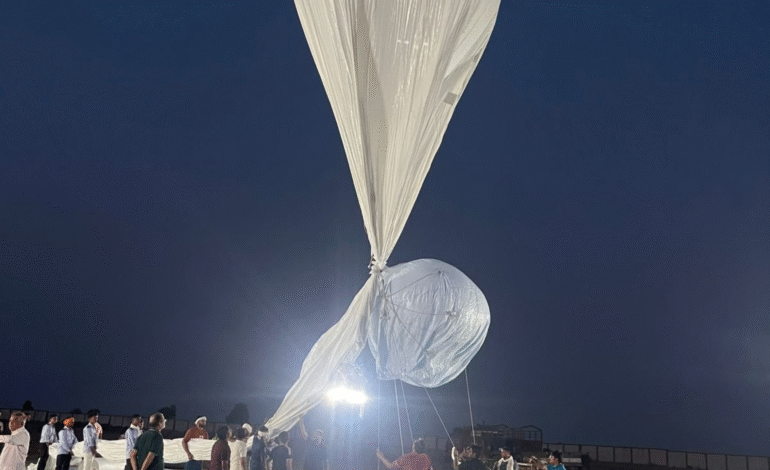India Tests Stratospheric Airship to Boost Military Surveillance

On May 3, 2025, India achieved a remarkable milestone in its defense technology when the Defence Research and Development Organisation (DRDO) successfully conducted its first-ever flight experiments with its stratospheric airship platform. This groundbreaking achievement positions India among a select group of nations with high-altitude, long-duration platforms that are set to revolutionize military and defense operations. The development promises a significant boost to India’s surveillance, reconnaissance, and national security capabilities.
Flight Tests of the Stratospheric Airship Platform in Madhya Pradesh
The flight tests were carried out in Sheopur, a key site for DRDO’s aerospace and defense research located in Madhya Pradesh. This region was chosen for its suitability in testing high-altitude airship systems. The primary goal was to assess the airship’s ability to carry an instrumental payload to stratospheric heights, specifically reaching around 17 kilometers (approximately 55,000 feet). The stratosphere, a region of the atmosphere where air is significantly thinner, presents unique challenges, particularly in terms of flight control and endurance.
The airship’s development is part of India’s broader defense strategy, which focuses on enhancing the country’s surveillance and reconnaissance capabilities. The platform, capable of flying at stratospheric altitudes for extended periods, promises to offer India a strategic advantage in military operations, intelligence gathering, and national security defense.
A Historic Milestone in High-Altitude Airship Development
The successful flight test is being hailed as a “milestone” by DRDO Chairman Samir V Kamat. This breakthrough represents a new chapter in India’s defense technology, combining cutting-edge engineering with advanced military strategies. The high-altitude platform system is designed to stay airborne for long durations, which provides India with the capacity to monitor critical regions, particularly along its borders.
India now joins an exclusive club of nations with the technical expertise to develop such high-tech, long-duration airship platforms. Historically, countries like the United States and Russia have dominated this sphere. However, India’s entry into this realm signifies an important leap forward in its defense capabilities.
Enhancing India’s Military Surveillance Capabilities
One of the primary benefits of the stratospheric airship platform is its ability to provide continuous surveillance over vast areas. Unlike satellites that follow fixed orbits and have limited coverage, the airship can remain stationary over key regions for extended periods, offering persistent and real-time monitoring. This is especially valuable for India’s defense needs, where the ability to maintain constant surveillance over sensitive border areas is crucial for national security.
The platform is equipped with state-of-the-art sensors and cameras designed to capture high-resolution imagery and real-time data. These tools allow the airship to monitor ground activities, detect movement, and collect vital intelligence. This real-time information can be analyzed by defense analysts to track enemy movements, coordinate military operations, and make informed decisions regarding national defense strategies.
Strategic Importance of the Test Amid Regional Tensions
The successful test flight holds particular significance in the context of escalating military tensions in the region, especially between India and Pakistan. In the wake of the Pahalgam terror attack, which occurred just before the test flight, the need for enhanced surveillance and intelligence-gathering technologies became more apparent. The airship’s ability to provide continuous real-time intelligence during such high-stakes situations is set to play a critical role in military standoffs, enabling more accurate and timely responses to crises.
Defense Minister Rajnath Singh expressed his appreciation for DRDO’s achievement, emphasizing the platform’s value for surveillance and reconnaissance missions, particularly in strategically sensitive regions. He also underscored the importance of self-reliance in defense technology, noting that India’s ability to develop such sophisticated systems domestically reduces its dependence on foreign suppliers and strengthens national security.
Technical Aspects of the Stratospheric Airship Platform
The development of the stratospheric airship platform has been a multi-year endeavor by the DRDO, with significant contributions from the Aerial Delivery Research and Development Establishment (ADRDE) in Agra. The design of the airship reflects years of research in aerodynamics, material science, and payload integration. A major challenge in creating this platform was ensuring it could operate effectively in the stratosphere, where conditions are far more extreme than at lower altitudes.
During the test flight, the airship successfully carried an instrumental payload to an altitude of 17 kilometers, a significant technical achievement. The onboard systems, including sensors, cameras, and communication devices, were rigorously tested, providing valuable data for future operational missions. The airship’s advanced envelope pressure control system, as well as its emergency deflation systems, were also evaluated to ensure the platform’s safety during extended flights. The 62-minute test flight provided crucial insights into the airship’s performance under real-world conditions.
DRDO’s Advancements in High-Altitude Airship Flight
This achievement marks a significant step in DRDO’s larger mission to enhance India’s air and space defense technologies. In recent years, the DRDO has made remarkable strides in developing various aerospace technologies, including unmanned aerial vehicles (UAVs), fighter jets, and satellite systems. The successful test flight of the stratospheric airship platform now adds a new dimension to India’s defense capabilities, providing the country with yet another advanced tool for military surveillance and reconnaissance.
With the airship now in operation, the Indian military gains more flexibility in conducting intelligence and reconnaissance missions. This capability allows for precise targeting, faster response times, and a more efficient defense infrastructure. The integration of such systems with India’s existing defense network further enhances the operational effectiveness of surveillance operations.
The Future of Stratospheric Airships and Strategic Applications
Looking to the future, the DRDO is expected to continue refining the stratospheric airship platform. Subsequent versions may feature enhanced sensors, extended range, and improved endurance, enabling the platform to carry out even more complex missions. Future iterations could also be equipped with additional capabilities such as advanced radar systems, communication relays, and electronic warfare capabilities, making it an even more valuable asset to India’s defense arsenal.
The airship’s unique ability to remain airborne for extended periods opens up numerous possibilities for military applications. It could play a crucial role in border surveillance, counter-terrorism operations, disaster management, and intelligence gathering. Its long-duration flight capabilities make it an ideal tool for monitoring sensitive areas and ensuring the safety of national borders. By offering continuous coverage, the airship provides a crucial edge in detecting unauthorized activity and tracking adversary movements.
Strengthening India’s Defense Landscape
India’s successful test of the stratospheric airship platform represents a significant leap forward in its defense technology. This milestone is indicative of the country’s growing technological self-sufficiency and its increasing prominence in the global defense sector. As the country continues to invest in cutting-edge defense technologies, the platform is expected to become a key component of India’s broader defense strategy, providing unmatched advantages in surveillance, reconnaissance, and military operations.
In the face of ever-evolving security challenges, India’s ability to develop and deploy high-tech systems like the stratospheric airship will prove invaluable. As tensions persist in the region, these technological advancements will play a critical role in securing the country’s borders, safeguarding national interests, and ensuring swift responses to emerging threats.
A New Era in Surveillance and Defense Technology
The successful testing of the stratospheric airship platform represents a pivotal moment in India’s defense journey. Its long-duration surveillance capabilities and high-altitude performance have the potential to transform India’s intelligence-gathering operations, offering unprecedented flexibility and precision. This achievement highlights India’s commitment to technological self-reliance and reinforces the nation’s strategic vision for a secure and resilient defense infrastructure.
As the DRDO continues to refine and expand upon this breakthrough, the stratospheric airship platform is poised to become an essential tool in India’s defense strategy. With its ability to provide continuous, real-time surveillance and reconnaissance, the platform enhances India’s operational capabilities and national security, marking the dawn of a new era in military defense.







